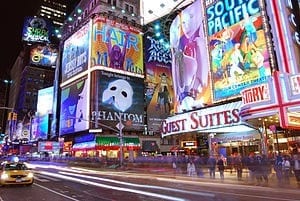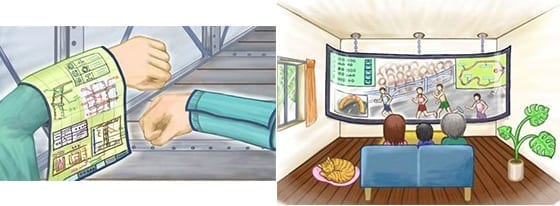
The plunging price of organic LED screens combined with cunning use of depth-sensing Kinect cameras heralds a quantum leap in interactive advertising
THE writing’s on the wall – and it’s following you. Two new gesture-sensing innovations designed for large electronic screens in public places herald a future in which everything from street art to advertisements track your movements, are fully interactive, and nigh on impossible to ignore.
Giant flat-screen displays powered by organic LEDs (OLEDs) are plunging in price, so screens tens of metres long could soon line urban corridors. Rather than have them simply fire messages at a tuned-out public, researchers at the Technical University of Berlin (TUB) in Germany have built two applications that they hope will captivate passers-by and inspire a new wave of interactive displays.
OLED flat-screen technology is already finding its way into our private spaces: homeowners will soon be able to cover whole living-room walls with screens like wallpaper. While TV companies ponder what content is best displayed on such vast indoor vistas, the TUB team has been working out what can be achieved with vast outdoor displays.
“We believe that in the future all surfaces in urban areas could be interactive displays,” says team member Robert Walter. “This presents great opportunities and challenges as it will need to be attractive and work in an intelligent way.” The researchers will reveal their first two street-smart applications – StrikeAPose and Screenfinity – next month at the CHI conference in Paris, France. They believe that while advertising could provide the impetus for the adoption of the technology, non-commercial apps will also appear – courtesy of artists or poets, perhaps.
StrikeAPose, developed by Walter’s team, lets a person in the street perform a unique gesture to take control of anything from a bus-shelter advert screen to a large, Times-Square-style video wall. Once you are registered as the screen controller, software fed by the depth cameras used in Microsoft’s Kinect system lets you control, say, a gesture-driven game. In trials in a university cafeteria, the team settled on a registration gesture they call The Teapot: users put their hands on both hips, their arms describing the profile of two teapot handles. This was the most robust gesture, even when obfuscated by thick clothing.
The Latest Bing News on:
Vast advertising displays
- Tobago shark attack: British man injured 10 metres from shoreon April 27, 2024 at 8:19 am
A British man has been seriously injured after being attacked by a shark on the Caribbean island of Tobago. The 64-year-old is receiving critical care after serious injuries to his left arm, left leg ...
- How Knox County lawmakers voted on controversial bills, including arming teachers and pride flagson April 24, 2024 at 9:38 am
Senators blocked a bill prohibiting the display of political and ideological ... stumbled out of the gate over vast differences between dueling Senate and House versions, in addition to ...
- Public Works Announces Guidelines for Political Advertisingon April 24, 2024 at 7:14 am
As election season nears, the V.I. Department of Public Works has issued new guidelines for political advertising in the territory, specifying that candidates can begin to display advertisements ...
- LAMR Lamar Advertising Companyon April 19, 2024 at 9:00 am
The company owns and operates billboards, logo signs, and transit advertising displays, as well as rents space for advertising on billboards, buses, shelters, benches, logo plates, and in airport ...
- Best rowing machines: Expert advice on choosing the right modelon April 18, 2024 at 1:52 am
Choosing the best rowing machine for your home gym is tricky, so learn which models are best for durability, affordability, bluetooth compatibility and more.
- The best 5K monitors you can buy for max resolutionon April 17, 2024 at 5:00 pm
These displays not only deliver exceptionally sharp and detailed imagery but also come with high-end, factory-calibrated panels to ensure precise color reproduction. A true 5K resolution is ...
- Vietnam Display Controller Market Analysis, Key Segments, Share, Size, Growth Status, and Forecast 2024 to 2032on April 17, 2024 at 3:03 pm
The Vietnam Display Controller Market has witnessed significant growth in recent years, driven by various factors such as technological advancements, increasing demand for high-resolution displays, ...
- Programmatic Display Market: Embarking on a Trajectory Towards US$ 901.65 Billion by 2033on April 16, 2024 at 6:55 pm
The programmatic display market is poised for remarkable growth, with an anticipated CAGR of 34.2%, culminating in a substantial revenue of US$ 901.65 billion. This surge can be attributed to the ...
- Review: iVANKY's FusionDock Max 1 Delivers Extreme Versatility With Dual Thunderbolt Connectivityon April 15, 2024 at 1:27 pm
Dock accessory company iVANKY recently launched its most powerful Thunderbolt dock yet, the FusionDock Max 1, which takes advantage of ...
The Latest Google Headlines on:
Vast advertising displays
[google_news title=”” keyword=”vast advertising displays” num_posts=”10″ blurb_length=”0″ show_thumb=”left”] [/vc_column_text]The Latest Bing News on:
Interactive advertising
- Lawyer marketing in the UK: What is the best solution?on April 26, 2024 at 5:05 am
This shift has brought about a plethora of marketing strategies, each with its own unique advantages and challenges. In this comprehensive analysis, we will delve into the multifaceted world of lawyer ...
- Exploring the Future of Animation: The Rise of Interactive Animation Technologieson April 25, 2024 at 12:59 pm
In the dynamic landscape of animation, a new era is dawning with the emergence of interactive animation technologies. Dive into the future of animation as we explore the transformative power of ...
- Asia's leading source of advertising, marketing & media news.on April 24, 2024 at 5:00 pm
MARKETING-INTERACTIVE is an online publication of Lighthouse Independent Media.
- 9 Marketing and Sales Conferences Leaders Should Keep on Their Radaron April 21, 2024 at 1:31 am
This year has been a year of change already. To stay in the know, here are some upcoming conferences for leaders in the marketing and sales space to check out.
- SBJ Tech: MVP Interactive steps up its game for clientson April 17, 2024 at 3:22 pm
The founder and CEO of mixed reality company MVP Interactive noticed a similar sentiment from potential sports venue clientele that didn’t sign on for an AR or VR fan experience collaboration. “We ...
- MVP Interactive brings sports advertising to non-endemic brandson April 17, 2024 at 2:36 pm
The founder and CEO of mixed reality company MVP Interactive noticed a similar sentiment from potential sports venue clientele that didn’t sign on for an AR or VR fan experience collaboration. “We ...
- U.S. Digital Advertising Revenues Hits High of $225Bon April 16, 2024 at 5:01 pm
Total digital advertising grew 7.3% in 2023 compared to 2022 while digital video ad revenue hit $52.3B in 2023 ...
- Navigating The Digital Marketing Landscape: Effective Strategies For Today's Marketon April 16, 2024 at 7:00 am
Digital marketing is not just about selling a product or service; it's about crafting brand experiences that resonate with consumers.
- Good Ideas for Sales & Interactive Marketingon January 21, 2022 at 12:35 pm
Interactive marketing involves personal conversations with customers, discussing their needs and what they are looking for, offering options for them to try, and general relationship building.
- The Advantages of Interactive Marketingon August 13, 2020 at 1:04 am
Interactive marketing is a type of advertising that includes several types of Internet sales strategies. These include social networking, website architecture and online stores. In today's world ...
The Latest Google Headlines on:
Interactive advertising
[google_news title=”” keyword=”interactive advertising” num_posts=”10″ blurb_length=”0″ show_thumb=”left”]










